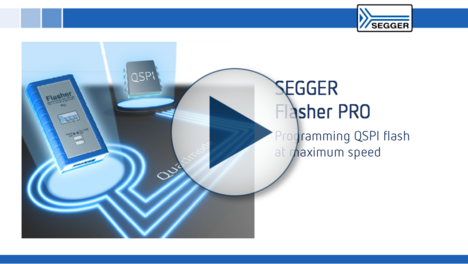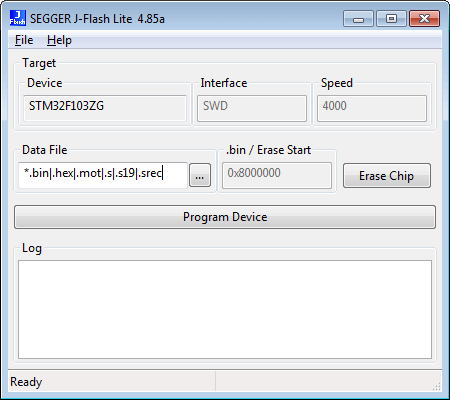All drivers support the following OS
The Device Install Kit download site does not provide access to all Emerson Process Management device files. Device files distributed on DeltaV and AMS Device Manager release media are not duplicated for download from this site. If your device can send UDP packets, it can also add support for the FIND protocol. Client side: Open UDP port 50022 in listening mode. Send a response to UDP port 50022 back to the query sender (unicast) Host side: Open UDP port 50022 in listening mode. Send a FIND query (UDP broadcast to port 50022) with payload FINDReq=1.
- Windows 10, 8.1, 8, 7 with Service Pack 1 (SP1)
- Windows Server 2016, 2012, 2008 R2
Main Drivers
Segger J Flash Lite Download
WBF (Windows Biometric Framework) drivers are the main drivers for most applications that use SecuGen fingerprint readers and devices containing SecuGen fingerprint USB sensors.
This installs WBF drivers for the following devices:

- Hamster IV (HSDU04P, HFDU04)
- Hamster Plus (HSDU03P, HSDU03M, HFDU03FR/FRS)
- Hamster Pro 10 (HU10)
- Hamster Pro 20 (HU20, HU20-A, HU20-AP)
- Hamster Pro Duo CL (XU20CL)
- Hamster Pro Duo SC/PIV (XU20SCA, XU20SCI, XU20SCP, XU20ASCA)
- ID-USB SC (XSDU03PSC, XSDU03MSC)
- ID-USB SC/PIV (XSDU04PSC, XFDU04SC)
- OptiMouse Plus (MSDU03P, MSDU03M, MFDU03FR/FRS)
- USB Sensors (FDU03FR/FRS, FDU04, SDU03M, SDU03P, SDU04P, U10, U20, U20-A, U20-AP, U20-ASF-U)
This supplies the WBF drivers for manual installation of the following devices:
- All of the devices listed above
- Hamster Pro (HUPx)
- USB Sensor (UPx)
Legacy Drivers
Some third party software that support SecuGen devices might require “Legacy” drivers instead of the main (WBF) drivers.
This installs legacy drivers for the following devices:
- Hamster IV (HSDU04P, HFDU04)
- Hamster Plus (HSDU03P, HSDU03M, HFDU03FR/FRS)
- Hamster Pro 10 (HU10)
- Hamster Pro 20 (HU20, HU20-A, HU20-AP)
- Hamster Pro Duo CL (XU20CL)
- Hamster Pro Duo SC/PIV (XU20SCA, XU20SCI, XU20SCP, XU20ASCA)
- ID-USB SC (XSDU03PSC, XSDU03MSC)
- ID-USB SC/PIV (XSDU04PSC, XFDU04SC)
- OptiMouse Plus (MSDU03P, MSDU03M, MFDU03FR/FRS)
- USB Sensors (FDU03FR/FRS, FDU04, SDU03M, SDU03P, SDU04P, U10, U20, U20-A, U20-AP, U20-ASF-U)
Individual legacy driver for manual installation of devices based on:
- UPx sensors (e.g. Hamster Pro, HUPx)
Individual legacy driver for manual installation of devices based on:
- U10 sensors
Individual legacy driver for manual installation of devices based on:
- U20 sensors
Individual legacy drivers for manual installation of devices based on:
- U20-A sensors
- U20-AP sensors
- U20-ASF-U sensors
Individual legacy drivers for manual installation of devices based on:
- FDU02 sensors
- FDU03 / SDU03 sensors
- FDU04 / SDU04 sensors
Other Downloads
SecuGen Fingerprint Management Application
(64-bit) (32-bit)

For Windows 7 only: Install this after installing the WBF driver. The FMA is used to enroll and manage fingerprints within Windows Biometric Framework applications on Windows 7 only. (FMA is not needed for later versions of Windows because the enroll and manage functions are natively included in those versions of Windows.)
For U20 and U10 type of devices only: Use this tool to configure the Fake Finger Rejection threshold and enable logging of events for devices based on the following sensors: U10, U20, U20-A, U20-AP
Any microcontroller, MPU, SoC with a supported CPU core with its debug interface accessible is supported and can be fully controlled by J-Link.
- 1.Known Devices
- 1.1.List of Known Devices
- 2.Adding support for new/unknown devices
- 3.Supported SPI flashes
ARM Cortex
Cortex-A/R 64-bit
- Cortex-A53
- Cortex-A72
Cortex-A/R 32-bit
- Cortex-A5
- Cortex-A7
- Cortex-A8
- Cortex-A9
- Cortex-A12
- Cortex-A15
- Cortex-A17
- Cortex-R4
- Cortex-R5
- Cortex-R8
Cortex-M
- Cortex-M0
- Cortex-M0+
- Cortex-M1
- Cortex-M3
- Cortex-M4
- Cortex-M7
- Cortex-M23
- Cortex-M33
- Cortex-M55
ARM (legacy cores)
Segger Jlink Downloads
- ARM720T
- ARM7TDMI
- ARM7TDMI-S
- ARM920T
- ARM922T
- ARM926EJ-S
- ARM946E-S
- ARM966E-S
- ARM1136JF-S
- ARM1136J-S
- ARM1156T2-S
- ARM1156T2F-S
- ARM1176JZ-S
- ARM1176JZF
- ARM1176JZF-S
Renesas RX
- Renesas RX110
- Renesas RX111
- Renesas RX113
- Renesas RX130
- Renesas RX210
- Renesas RX21A
- Renesas RX220
- Renesas RX231
- Renesas RX23T
- Renesas RX24T
- Renesas RX610
- Renesas RX621
- Renesas RX62G
- Renesas RX62N
- Renesas RX62T
- Renesas RX630
- Renesas RX631
- Renesas RX63N
- Renesas RX63T
- Renesas RX64M
- Renesas RX65N
- Renesas RX651
- Renesas RX66T
- Renesas RX71M
Microchip PIC
- Microchip PIC32MX
- Microchip PIC32MZ
- Microchip PIC32WK
Silicon Labs 8051
RISC-V
- RV32
- RV64
- AndesTech A25 core (RV32)
- SiFive E31 core (RV32)
Known devices are supported devices which are also known by name. Knowing not just the CPU core, but also the device by name brings the following advantages:
Segger Jlink Driver Windows 10
- Programming of internal flash (See Flash Download)
- Availability of unlimited number of breakpoints in flash memory (See Flash Breakpoints)
- Known memory map allows speed optimizations for access to Flash andRAM
- Support for non-standard CPU-cores & bugs in silicon: Some silicon requires special sequences for unlock, reset, or simply connecting to the core. For known devices, this is implemented
Note that a device has not to be known by name to be supported. This means that J-Link can be used with any device, using a standard core listed in the table of supported CPU cores even if it is known by name.

List of Known Devices
The following list gives an overview about which devices are known by J-Link. Note that your device may still be supported even if it is not in this list, as long as it incorporates a core that is listed in Supported CPU Cores. In case of doubt, please feel free to get in touch with SEGGER.
The list from below is always valid for the latest version (highest version number) of the J-Link/Flasher software package. This may be a release (even version number) or beta version (odd version number), since support for some devices is usually added in a beta phase first.
If a device is not listed in the list of known devices on this page, there are two options to get it to be known by J-Link:
- Adding support for it (incl. flash programming) on your own. For more information on how to do this, please refer to the SEGGER wiki.
- Get in touch with support@segger.com and issue a device support request
Note that a device has not to be known by name to be supported. This means that J-Link can be used with any device, using a standard core listed in Supported CPU Cores even if it is known by name.
Supported SPI flashes
Segger Port Devices Driver Download Windows 10
J-Link does also support download into SPIFI (SPI Flash Interface) flashes in case they are memory mapped readable through the CPU (called SPIFI support on most targets). Moreover, utilities like J-Flash SPI also support direct programming of SPI flashes without any CPU in between. The following SPI flashes are currently supported by the J-Link software.
More Information
Segger Debugger
Purchase
Technology
Accessories
Tools
Models

